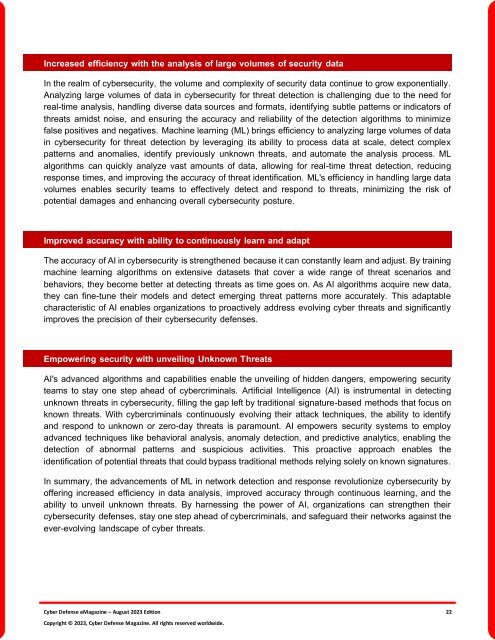The Cyber Defense eMagazine August Edition for 2023
Cyber Defense eMagazine August Edition for 2023 #CDM #CYBERDEFENSEMAG @CyberDefenseMag by @Miliefsky a world-renowned cyber security expert and the Publisher of Cyber Defense Magazine as part of the Cyber Defense Media Group as well as Yan Ross, Editor-in-Chief and many more writers, partners and supporters who make this an awesome publication! Thank you all and to our readers! OSINT ROCKS! #CDM #CDMG #OSINT #CYBERSECURITY #INFOSEC #BEST #PRACTICES #TIPS #TECHNIQUES
Cyber Defense eMagazine August Edition for 2023 #CDM #CYBERDEFENSEMAG @CyberDefenseMag by @Miliefsky a world-renowned cyber security expert and the Publisher of Cyber Defense Magazine as part of the Cyber Defense Media Group as well as Yan Ross, Editor-in-Chief and many more writers, partners and supporters who make this an awesome publication! Thank you all and to our readers! OSINT ROCKS! #CDM #CDMG #OSINT #CYBERSECURITY #INFOSEC #BEST #PRACTICES #TIPS #TECHNIQUES
Create successful ePaper yourself
Turn your PDF publications into a flip-book with our unique Google optimized e-Paper software.
Increased efficiency with the analysis of large volumes of security data<br />
In the realm of cybersecurity, the volume and complexity of security data continue to grow exponentially.<br />
Analyzing large volumes of data in cybersecurity <strong>for</strong> threat detection is challenging due to the need <strong>for</strong><br />
real-time analysis, handling diverse data sources and <strong>for</strong>mats, identifying subtle patterns or indicators of<br />
threats amidst noise, and ensuring the accuracy and reliability of the detection algorithms to minimize<br />
false positives and negatives. Machine learning (ML) brings efficiency to analyzing large volumes of data<br />
in cybersecurity <strong>for</strong> threat detection by leveraging its ability to process data at scale, detect complex<br />
patterns and anomalies, identify previously unknown threats, and automate the analysis process. ML<br />
algorithms can quickly analyze vast amounts of data, allowing <strong>for</strong> real-time threat detection, reducing<br />
response times, and improving the accuracy of threat identification. ML's efficiency in handling large data<br />
volumes enables security teams to effectively detect and respond to threats, minimizing the risk of<br />
potential damages and enhancing overall cybersecurity posture.<br />
Improved accuracy with ability to continuously learn and adapt<br />
<strong>The</strong> accuracy of AI in cybersecurity is strengthened because it can constantly learn and adjust. By training<br />
machine learning algorithms on extensive datasets that cover a wide range of threat scenarios and<br />
behaviors, they become better at detecting threats as time goes on. As AI algorithms acquire new data,<br />
they can fine-tune their models and detect emerging threat patterns more accurately. This adaptable<br />
characteristic of AI enables organizations to proactively address evolving cyber threats and significantly<br />
improves the precision of their cybersecurity defenses.<br />
Empowering security with unveiling Unknown Threats<br />
AI's advanced algorithms and capabilities enable the unveiling of hidden dangers, empowering security<br />
teams to stay one step ahead of cybercriminals. Artificial Intelligence (AI) is instrumental in detecting<br />
unknown threats in cybersecurity, filling the gap left by traditional signature-based methods that focus on<br />
known threats. With cybercriminals continuously evolving their attack techniques, the ability to identify<br />
and respond to unknown or zero-day threats is paramount. AI empowers security systems to employ<br />
advanced techniques like behavioral analysis, anomaly detection, and predictive analytics, enabling the<br />
detection of abnormal patterns and suspicious activities. This proactive approach enables the<br />
identification of potential threats that could bypass traditional methods relying solely on known signatures.<br />
In summary, the advancements of ML in network detection and response revolutionize cybersecurity by<br />
offering increased efficiency in data analysis, improved accuracy through continuous learning, and the<br />
ability to unveil unknown threats. By harnessing the power of AI, organizations can strengthen their<br />
cybersecurity defenses, stay one step ahead of cybercriminals, and safeguard their networks against the<br />
ever-evolving landscape of cyber threats.<br />
<strong>Cyber</strong> <strong>Defense</strong> <strong>eMagazine</strong> – <strong>August</strong> <strong>2023</strong> <strong>Edition</strong> 22<br />
Copyright © <strong>2023</strong>, <strong>Cyber</strong> <strong>Defense</strong> Magazine. All rights reserved worldwide.

















